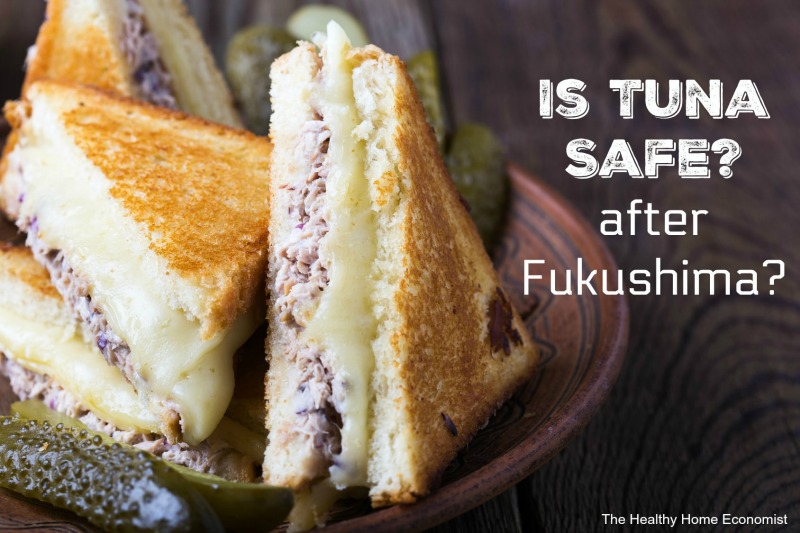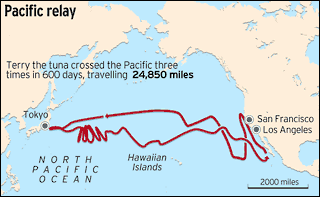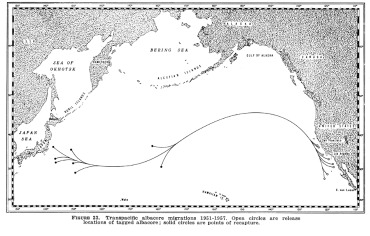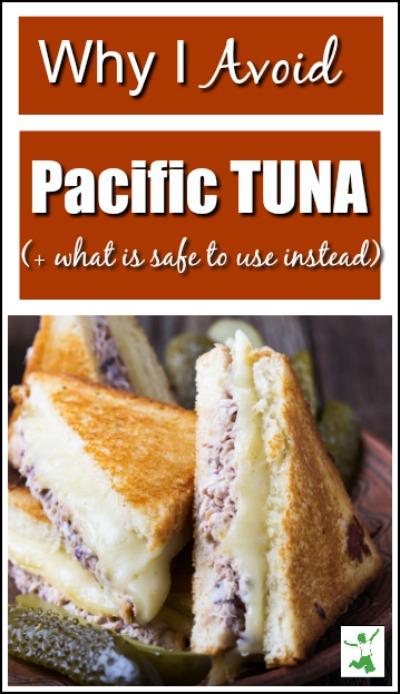
Tuna has always been a staple Real Food in our home. I’ve always taken care to source low mercury, sustainably caught tuna in order to prepare quality tuna steaks for dinner, tuna melts for lunch, or that old standby tuna salad for lunch boxes, quick snacks or just a dollop on a bed of greens. Spicy bluefin tuna rolls are a favorite of my husband when dining at Japanese restaurants.
About a year ago, however, I started to question my choice of tuna for regular consumption. I began reading the reports about the spreading radiation plume in the Pacific from the continuing Fukushima nuclear disaster. I delved into the migratory patterns of various species of tuna. The more I read, the more concerned, and quite frankly, confused I became.
Realizing that my family’s health can’t be wagered on guesses or half-truths, I gathered as much information as I could to arrive at an informed decision. Here’s what I found.
All species of tuna are highly migratory. This means that they swim long distances pretty much throughout their entire lives. These migration patterns are still ill-understood although it is generally agreed upon that they are large.

Pacific bluefin tuna are born near Japan spending their early months swimming in the radiation plume there. They then swim back and forth across the Pacific their entire lives. One tuna nicknamed Terry crossed the Pacific no less than 3 times in the span of only 20 months coming very close to Japan each time. To the right is a chart showing his epic swim.
The information gleaned from Terry the tuna is not new. As early as the 1950’s, tagged albacore tuna were known to swim thousands of miles as shown in this second chart to the right. The open circles off the California coast indicate where they were released and the solid circles closer to Japan indicates where they were recaptured.
 Highly migratory indeed!
Highly migratory indeed!
Atlantic based tuna exhibit the same nomadic patterns. According to National Geographic, high tech tags of Atlantic bluefin tuna revealed the following:
A team of international scientists documented two giant bluefins tagged within minutes of each other off the coast of Ireland. The two fish swam to opposite sides of the Atlantic Ocean–ending up more than 3,000 miles (5,000 kilometers) apart. One of the fish traveled 3,730 miles (6,000 kilometers) southwest to waters about 186 miles (300 kilometers) northeast of Cuba. The other remained in the eastern Atlantic and moved off the coasts of Portugal.
According to the Food and Agriculture Organization of the United Nation (FAO)s, all species of tuna, not just bluefin and albacore, are considered highly migratory, again with the reasons for these patterns not well understood. Here is a breakdown of the tuna species and where they are located according to a report by the FAO:
- Albacore tuna (Thunnus alalunga), which occurs in tropical and temperate waters worldwide.
- Bluefin tuna (Thunnus thynnus), mostly found in temperate waters of the Atlantic, including the Mediterranean, and Pacific Oceans. It is noted that since the adoption of UNCLOS, bluefin tuna in the northern Pacific has been identified as a different species, Pacific bluefin tuna (Thunnus orientalis) while bluefin in the Atlantic has been re-named Atlantic bluefin tuna.
- Bigeye tuna (Thunnus obesus), found in the Atlantic (but absent from the Mediterranean), Indian and Pacific Oceans.
- Skipjack tuna (Katsuwonus pelamis) with a worldwide distribution in tropical and temperate waters.
- Yellowfin tuna (Thunnus albacares), also with a worldwide distribution in tropical and sub-tropical more temperate seas, but absent from the Mediterranean.
- Blackfin tuna (Thunnus atlanticus) found in the western Atlantic in tropical and warm seas.
- Little tuna (Euthynnus alleteratus and E. affinis), with E. alleteratus found in tropical and subtropical waters of the Atlantic, including the Mediterranean, the Black Sea, the Caribbean Sea and the Gulf of Mexico, and E. affinis in the Indian and Pacific Oceans. It is noted that presently, E. alleteratus is called little tunny and E. affinis is called kawakawa.
- Southern bluefin tuna (Thunnus maccoyii), in temperate waters of the southern hemisphere in the Atlantic, Indian and Pacific Oceans.
- Frigate and bullet tuna (Auxis thazard and A. rochei) found in the Atlantic (including the Mediterranean Sea where only A. rochei is found), Indian and Pacific Oceans.
So Tuna Swim. A Lot. So What?
The fact that tuna swim great distances, constantly moving and migrating means that tuna in the Pacific more than likely will have passed through the growing Fukushima radiation plume at some point in their lives, probably numerous times.
With long-lived varieties like albacore (11-12 years) and bluefin (up to 20 years), this is especially true. With much smaller, shorter-lived tuna like the skipjack (about 8 years), less so.
Is the Fukushima Radiation Even Really a Problem?
The answer to this question depends on who you ask. Some reports say yes, the Pacific-based radiation plume from Fukushima is a serious problem and growing worse as 300 tons of radioactive water pours into the Pacific every single day with no end in sight for years. Unbelievably, Japan’s government only acknowledged the urgency of the situation in September 2013.
On the other hand, a comprehensive assessment by the World Health Organization (WHO) concluded that radioactive particles that are making their way to North American waters will have a limited effect on human health, with concentrations below WHO safety levels.
The most unsettling data to date is that the continued outflow of radioactive water from Fukushima now no longer just contains cesium isotopes. It now also contains the more worrisome strontium-90 which is a bone-seeking isotope.
Who is right? Who is wrong?
One thing is true, Fukushima is a nuclear disaster never before experienced in human history so all theories and probabilities are on the table.
Dr. Ken Buessler, a world expert in marine radioactivity with the Woods Hole Oceanographic Institution in Massachusetts who is leading an international research team tracking Fukushima’s trails in the Pacific has this to say:
We still don’t know the answers to many important questions concerning the impacts of Fukushima radionuclides on the oceans. For example, we still don’t have a good handle on how much radioactivity was released, and we don’t fully understand where it has ended up, and that holds for the ocean waters, seafloor sediments, and for marine biota, such as tuna.
Caution Seems to Be the Best Policy
Having personally known someone who died of radiation-induced cancer 15 years after the Chernobyl disaster from the fallout that blanketed parts of Europe which governments at the time said was no threat to human health (his wife lost most of her hair but has survived although they tragically had a daughter born a few years after the disaster who developed leukemia), I don’t take the long term, cumulative effects of radiation lightly and interpret official reports like the one published by the WHO with a grain of salt.
If you choose to interpret the data as a nonthreat to human health with the radiation levels within safe limits, that is, of course, your choice. My approach is both practical and cautionary to play it safe for my children’s sake until more information is gathered and the extent of the problem studied further. This includes avoiding all tuna from Pacific waters given that this particular migratory fish is prone to swimming close to Japan multiple times during its lifetime.
Since much of the time, the ocean of origin for tuna is unknown or not labeled, this would mean avoiding all tuna in most cases. This is exactly what I’ve been doing for the past six months or so – no tuna in my home. Period.
The complaining of my family about the absence of tuna dishes (which everyone loves) has caused me to continue to search for a source of tuna I would feel comfortable serving. I recently discovered a skipjack tuna from Portugal (source) that I’ve been purchasing for several years.
Buy Atlantic Based Tuna!
Given that Atlantic based tuna do not enter the Pacific during their lives, I felt at this time, this brand of sustainably-fished Atlantic tuna would be safe to eat.
However, predictions are for the Fukushima radiation plume to continue growing, eventually entering the Arctic and then the Atlantic Oceans, as the disaster is far from contained. As a result, this situation most likely will change in the coming years. For now, however, if tuna origin can be accurately confirmed, I will purchase and eat it – but only from the Atlantic Ocean and other non-Pacific sources.
What are your thoughts about eating tuna and other seafood? What data have you come across to support your decision? Do you continue to eat tuna? Why or why not?

References
(1) Radiation From Fukushima Could Help Solve the Mystery of Bluefin Tuna Migration
(2) Health risk assessment from the nuclear accident after the 2011 Great East Japan earthquake and tsunami, based on a preliminary dose estimation
(3) Tagged Tuna Reveal Migration Secrets
(4) Tuna’s 25,000 Mile Swim Down Marine Highway
(5) The Migration, Age, and Growth of Pacific Albacore (1951-1958)
(6) Should you Worry about Radiation in your Wild Pacific Fish?
(7) Highly Migratory Species of Fish
(8) Tuna Species








Regardless of your position on this issue, I applaud Sarah for being willing to research it and decide what works best for her and her family. As of now, my family will also use caution and seek out only non-Pacific sources of tuna.
Of course its the only tuna Radiant Life sells. Its like you write your articles for the sole purpose of pushing their overpriced products. It really makes me wonder if I should be following you. Just my two cents about that.
How about a little critical thinking,
Sarah sourced good healthy non toxic food Radiant Life supplies it. The Vote with your dollar is the vote that favors you, and, when you buy real food, it wont be dirt cheap like that convenient devitalized cheap cheap corporate food, guaranteed to make health insurance a value at any price. Opt out and vote with your dollar buying real food that insures your health the right way.
Thanks Sarah, I love that Emu Oil you recommended the other day, Radiant Life is speedy in their delivery.
Nothing in this world is 100% safe. Just do the best you can. We will all die someday.
Thanks for the great report. I will miss the Wild Alaskan Salmon more than any tuna. I was never fond of any Atlantic caught salmon as most found are farm raised. They never taste fresh.
Looks like I should get a Geiger counter to inspect sea food before eating it.
What about sea vegetables? We buy from Eden foods, I am assuming these would be contaminated as well?
Thank you for your article! I have read so many articles since Fukushima that are full of misleading and confusing information. My husband was in the nuclear power field for 12 years, so I have trusted him to be the researcher in our family regarding this. For our family, we avoid all Pacific seafood, including Alaska salmon. (We’ve not done much research on the Alaska fish and river waters, so avoid it as a precaution. I’ve read such contradictory information!) This is especially important for children, as they have longer for their health to be effected. I love seafood, so this has been hard, especially as we live on the West Coast. Breast feeding my son has been my motivation to not take a chance with his health!
Be careful with iodine supplementation. I originally decided it was prudent to supplement with a low dose of iodine after fukishima. This caused iodine induced hypothyroidism. Luckily, I knew enough to see a holistic endocrinologist after a nurse practitioner prescribed thyroid medication for life. My doc helped me heal the accidental poisoning I did to myself with iodine. (All of that and I have a master’s degree in holistic health, which helps me make very educated decisions.)
My thyroid tests back in the normal range, yet I am still 15 lbs up and feel some symptoms of hypothyroid. This can take a couple of years to re balance, even with in labs in range.
Aside from all of the potential radiation you’d be eating if you eat fish, my sources are more concerned about mercury. I have Six MD friends, all with different specialties, and none will eat fish anymore due to mercury. I have a handful of additional doc friends who will eat it, but only once per month. One Dr. friend of mine had a patient who went to fish mongers in the hawaiin islands, and alaska, and had every single fish available for purchase lab tested. NOT ONE was within “acceptable” ranges for heavy metals.
So Sad–our oceans are poisoned.
Nancy, what do you think of this product? I just started a bottle of it for adrenal support, to try to fight night sweats (I am far from menopause).
http://www.standardprocess.com/Products/Standard-Process/Prolamine-Iodine
Sara – If you are having night sweats and it’s not menopause you might want to visit somebody who practices Chinese medicine for acupuncture and herbs. They are really good at figuring out the root cause of your problem and bringing you back into balance.
For constant updates on the Fukushima situation, suggest you start with
the following link:
http://enenews.com
(we had to face the harsh reality that no seafood is safe to eat)
Excellent source of information.
Right on!
Test
Thanks for your research & for bringing this issue to the forefront again. Beyond the radiation issue, what about the Atlantic Ocean BP oil spill + the chemicals used for cleanup? Seems there are frequent oil spills everywhere (Exxon, Costa Concordia, etc). We need to be concerned with ALL ocean currents.
And the media wonders why whales are beaching themselves!
Some people never left Chernobyl & they look pretty healthy after 27 years. Some are moving back to live there even tho radioactive readings are still unacceptable. Oddly enough, they grow & eat the food there. Perhaps their thyroids were filled with enough iodine just in time before health damage could set in. A recent TV documentary I saw didn’t offer any conclusions why. The residents they interviewed were probably in their 80’s. Chernobyl is now a tourist attraction – go figure!
The only fish I eat right now are Canadian Sardines. IMO they are small & young enough not to consume enough of the ocean radiation & contaminants. And FWIW, I take seaweed capsules & sometimes powdered kelp.
http://en.wikipedia.org/wiki/Ocean_current